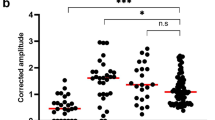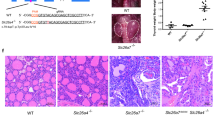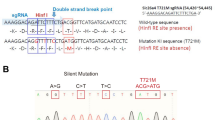Abstract
Pendred syndrome and non-syndromic recessive deafness associated with enlarged vestibular aqueduct (NSRD with EVA) are caused by mutations in the SLC26A4 (PDS) gene. Unlike NSRD with EVA, Pendred syndrome is characterized by goiter, which may be present after early adulthood. However, the clinical diagnosis of these two disorders is difficult in deaf children. Expression of the SLC26A4 gene may be responsible for iodide transport in the thyroid as well as for formation and function of the inner ear. Here, we analyzed the SLC26A4 gene and performed thyroid function tests (FT3, FT4, TSH, and Thyroglobulin) on six congenitally deaf infants (mean age 2.7 years) with EVA. Mutation of the SLC26A4 gene was identified in five patients: four were compound heterozygous (H723R/919−2A>G, H723R/IVS15+5G>A, H723R/R581S, IVS7-2A>G/IVS8+1G>A), the fifth had a frameshift mutation (322delC). All the patients demonstrated an elevation of serum thyroglobulin level. FT3 level was elevated in four of the five patients. The patient who did not have a detectable gene mutation showed normal thyroid function. We conclude that the mutations in the SLC26A4 gene identified here are highly associated with high serum thyroglobulin levels in congenital and deafness infants. These mutations may be of value for the diagnosis of Pendred syndrome and NSRD with EVA.
Similar content being viewed by others
Log in or create a free account to read this content
Gain free access to this article, as well as selected content from this journal and more on nature.com
or
References
Campbell C, Cucci RA, Prasad A, Green GE, Edeal JB, Galer CE, Karniski LP, Sheffield VC, Smith RJH (2001) Pendred syndrome, DFNB4, and PDS/SLC26A4 identification of eight novel mutation and possible genotype–phenotype correlations. Hum Mutat 17:404–411
Dentice M, Luongo C, Elefante A, Ambrosio R, Salzano S, Zannini M, Nitsch R, Lauro RD, Rossi G, Fenzi G, Salvatore D (2005) Pendrin is a novel in vivo downstream target gene of the TTF-1/Nkx-2.1 homeodomain transcription factor in differentiated thyroid cells. Mol Cell Biol 25:10171–10182
Everett LA, Glaser B, Beck JC, Idol JR, Buchs A, Heyman M, Adawi F, Hazani E, Nassir E, Baxevanis A, Sheffield VC, Green ED (1997) Pendred syndrome is caused by mutation in a putative sulphate transporter gene (PDS). Nat Genet 17:411–422
Everett LA, Morsli H, Wu DK, Green ED (1999) Expression pattern of the mouse ortholog of the Pendred’s syndrome gene (PDS) suggests a key role for pendrin in the inner ear. Proc Natl Acad Sci USA 969:727–732
Fugazzola L, Cerutti N, Mannavola D, Vannucchi G, Beck-Peccoz P (2001) The role of pendrin in iodide regulation. Exp Clin Endocr Diab 109:18–22
Giraud A, Dicristofaro J, De Micco C, Lejeune PJ, Barbaria J, Mallet B (2005) A plasminogen-like protein, oresent in the apical extracellular environment thyroid epithelial cells, degrades thyroglobulin in vitro. Biochem Biophys Res Commun 338:1000–1004
Gorlin RJ (1995) Genetic hearing loss associated with endocrine and metabolic disorders. In: Gorlin RJ (ed) Hereditary hearing loss and its syndromes. Oxford University Press, New York, pp 337–339
Massa G, Jaenen N, de Varebeke SJ, Peeters N, Wuyts W (2003) Solitary thyroid nodule as presenting symptom of Pendred syndrome caused by a novel splice-site mutation in intron 8 of the SLC26A4 gene. Eur J Pediatr 162:674–677
Morton NE (1991) Genetic epidemiology of hearing impairment. Ann NY Acad Sci 630:16–31
Park HJ, Shaukat S, Liu XZ, Hahn SH, Naz S, Ghosh M, Kim HN, Moon SK, Abe S, Tukamoto K, Riazuddin S, Kabra M, Erdenetungalag R, Radnaabazar J, Khan S, Pandya A, Usami SI, Nance WE, Wilcox ER, Griffith AJ (2003) Origines and frequencies of SLC26A4 (PDS) mutations in east and south Asians: global implications for the epidemiology of deafness. J Med Genet 40:242–248
Pendred V (1986) Deaf mutism and goiter. Lancet 2:532
Reardon W, Coffey R, Chowdhury T, Grossman A, Jan H, Britton K, Kendall-Taylor P, Trembath R (1999) Prevalence, age of onset, and natural history of thyroid disease in pendred syndrome. J Med Genet 36:595–598
Royaux IE, Suzuki K, Mori A, Katoh R, Everett LA, Kohn LD, Green ED (2000) Pendrin, the protein encoded by the Pendred syndrome gene (PDS), is an apical porter of iodide in the thyroid and is regulated by thyrogloglin in FRTL-5 cells. Endcrinology 141:839–845
Scinicariello F, Murray HE, Smith L, Wilbur S, Fowler BA (2005) Genetic factors that might lead to different responses in individuals exposed to perchlorate. Environ Health Perspect 113:1479–1484
Tsukamoto K, Suzuki H, Harada D, Namba A, Abe S, Usami S (2003) Distribution and frequencies of PDS (SLC26A4) mutations in Pendred syndrome and nonsyndromic hearing loss associated with enlarged vestibular aqueduct: a unique spectrum of mutations in Japanese. Eur J Hum Genet 11:916–922
Usami S, Abe S, Weston MD, Shinkawa H, Van Camp G, Kimberling WJ (1999) Non-syndromic hearing loss associated with enlarged vestibular aqueduct is caused by PDS mutations. Hum Genet 104:117–200
Yang JJ, Tsai CC, Hsu HM, Shiao JY, Su CC, Li SY (2005) Hearing loss associated with enlarged vestibular aqueduct and Mondini dysplasia is caused by splice-site mutation in the PDS gene. Hear Res 199:22–30
Acknowledgment
This work was supported by the Acute Profound Deafness Research Committee of the Ministry of Health, Labour and Welfare, Tokyo, Japan.
Author information
Authors and Affiliations
Corresponding author
Rights and permissions
About this article
Cite this article
Iwasaki, S., Tsukamoto, K., Usami, S. et al. Association of SLC26A4 muations with clinical features and thyroid function in deaf infants with enlarged vestibular aqueduct. J Hum Genet 51, 805–810 (2006). https://doi.org/10.1007/s10038-006-0027-z
Received:
Accepted:
Published:
Issue date:
DOI: https://doi.org/10.1007/s10038-006-0027-z
Keywords
This article is cited by
-
Mutation spectrum and genotype–phenotype correlation of hearing loss patients caused by SLC26A4 mutations in the Japanese: a large cohort study
Journal of Human Genetics (2014)
-
Pathogenic substitution of IVS15 + 5G > A in SLC26A4 in patients of Okinawa Islands with enlarged vestibular aqueduct syndrome or Pendred syndrome
BMC Medical Genetics (2013)
-
Identification of SLC26A4 c.919-2A>G compound heterozygosity in hearing-impaired patients to improve genetic counseling
Journal of Translational Medicine (2012)



